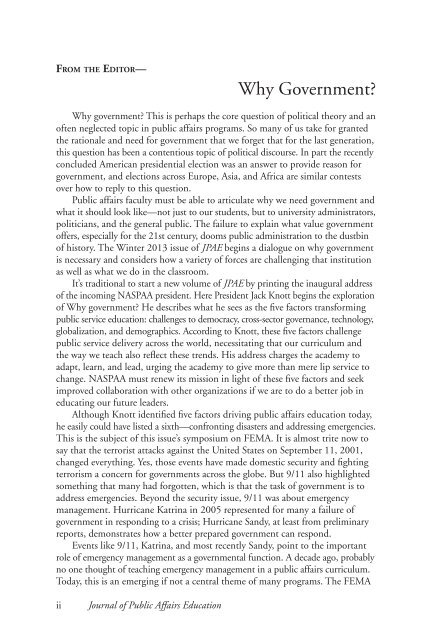Download - National Association of Schools of Public Affairs and ...
Download - National Association of Schools of Public Affairs and ...
Download - National Association of Schools of Public Affairs and ...
You also want an ePaper? Increase the reach of your titles
YUMPU automatically turns print PDFs into web optimized ePapers that Google loves.
From the Editor—<br />
Why Government?<br />
Why government? This is perhaps the core question <strong>of</strong> political theory <strong>and</strong> an<br />
<strong>of</strong>ten neglected topic in public affairs programs. So many <strong>of</strong> us take for granted<br />
the rationale <strong>and</strong> need for government that we forget that for the last generation,<br />
this question has been a contentious topic <strong>of</strong> political discourse. In part the recently<br />
concluded American presidential election was an answer to provide reason for<br />
government, <strong>and</strong> elections across Europe, Asia, <strong>and</strong> Africa are similar contests<br />
over how to reply to this question.<br />
<strong>Public</strong> affairs faculty must be able to articulate why we need government <strong>and</strong><br />
what it should look like—not just to our students, but to university administrators,<br />
politicians, <strong>and</strong> the general public. The failure to explain what value government<br />
<strong>of</strong>fers, especially for the 21st century, dooms public administration to the dustbin<br />
<strong>of</strong> history. The Winter 2013 issue <strong>of</strong> JPAE begins a dialogue on why government<br />
is necessary <strong>and</strong> considers how a variety <strong>of</strong> forces are challenging that institution<br />
as well as what we do in the classroom.<br />
It’s traditional to start a new volume <strong>of</strong> JPAE by printing the inaugural address<br />
<strong>of</strong> the incoming NASPAA president. Here President Jack Knott begins the exploration<br />
<strong>of</strong> Why government? He describes what he sees as the five factors transforming<br />
public service education: challenges to democracy, cross-sector governance, technology,<br />
globalization, <strong>and</strong> demographics. According to Knott, these five factors challenge<br />
public service delivery across the world, necessitating that our curriculum <strong>and</strong><br />
the way we teach also reflect these trends. His address charges the academy to<br />
adapt, learn, <strong>and</strong> lead, urging the academy to give more than mere lip service to<br />
change. NASPAA must renew its mission in light <strong>of</strong> these five factors <strong>and</strong> seek<br />
improved collaboration with other organizations if we are to do a better job in<br />
educating our future leaders.<br />
Although Knott identified five factors driving public affairs education today,<br />
he easily could have listed a sixth—confronting disasters <strong>and</strong> addressing emergencies.<br />
This is the subject <strong>of</strong> this issue’s symposium on FEMA. It is almost trite now to<br />
say that the terrorist attacks against the United States on September 11, 2001,<br />
changed everything. Yes, those events have made domestic security <strong>and</strong> fighting<br />
terrorism a concern for governments across the globe. But 9/11 also highlighted<br />
something that many had forgotten, which is that the task <strong>of</strong> government is to<br />
address emergencies. Beyond the security issue, 9/11 was about emergency<br />
management. Hurricane Katrina in 2005 represented for many a failure <strong>of</strong><br />
government in responding to a crisis; Hurricane S<strong>and</strong>y, at least from preliminary<br />
reports, demonstrates how a better prepared government can respond.<br />
Events like 9/11, Katrina, <strong>and</strong> most recently S<strong>and</strong>y, point to the important<br />
role <strong>of</strong> emergency management as a governmental function. A decade ago, probably<br />
no one thought <strong>of</strong> teaching emergency management in a public affairs curriculum.<br />
Today, this is an emerging if not a central theme <strong>of</strong> many programs. The FEMA<br />
ii<br />
Journal <strong>of</strong> <strong>Public</strong> <strong>Affairs</strong> Education

















